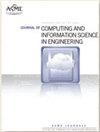Multi-UAV Assisted Flood Navigation of Waterborne Vehicles using Deep Reinforcement Learning
IF 2.6
3区 工程技术
Q2 COMPUTER SCIENCE, INTERDISCIPLINARY APPLICATIONS
Journal of Computing and Information Science in Engineering
Pub Date : 2024-07-19
DOI:10.1115/1.4066025
引用次数: 0
Abstract
During disasters, such as floods, it is crucial to get real-time ground information for planning rescue and response operations. With the advent of technology, Unmanned Aerial Vehicles (UAVs) are being deployed for real-time path planning to provide support to evacuation teams. However, their dependency on expert human pilots for command and control limits their operational capacity to the line-of-sight range. In this paper, we utilize a Deep Reinforcement Learning algorithm to autonomously control multiple UAVs for area coverage. The objective is to identify serviceable paths for safe navigation of waterborne evacuation vehicles (WBVs) to reach critical location(s) during floods. The UAVs are tasked to capture the obstacle-related data and identify shallow water regions for unrestricted motion of the WBV(s). The data gathered by UAVs is used by the Minimum expansion A* (MEA*) algorithm for path planning to assist WBV(s). MEA* addresses the node expansion issue with the standard A* algorithm, by pruning the unserviceable nodes/locations based on the captured information, hence expediting the path planning process. The proposed approach, MEA*MADDPG, is compared with other prevalent techniques from the literature over simulated flood environments with moving obstacles. The results highlight the significance of the proposed model as it outperforms other techniques when compared over various performance metrics.使用深度强化学习的多无人机辅助水上飞行器洪水导航
在洪水等灾害期间,获取实时地面信息对于规划救援和响应行动至关重要。随着技术的发展,无人驾驶飞行器(UAV)被部署用于实时路径规划,为疏散小组提供支持。然而,无人飞行器的指挥和控制依赖于专业的人类飞行员,这限制了其在视线范围内的行动能力。在本文中,我们利用深度强化学习算法自主控制多架无人机进行区域覆盖。我们的目标是在洪水期间为水上撤离车辆(WBV)的安全导航确定可用路径,以便其到达关键地点。无人机的任务是捕捉与障碍物相关的数据,并识别浅水区域,以便水上撤离车(WBV)不受限制地移动。无人机收集的数据被最小扩展 A* (MEA*) 算法用于路径规划,以协助 WBV(s)。MEA* 算法根据采集到的信息修剪无法使用的节点/位置,从而加快了路径规划过程,解决了标准 A* 算法的节点扩展问题。在带有移动障碍物的模拟洪水环境中,将所提出的 MEA*MADDPG 方法与文献中的其他流行技术进行了比较。结果凸显了所提模型的重要性,因为它在各种性能指标的比较中优于其他技术。
本文章由计算机程序翻译,如有差异,请以英文原文为准。
求助全文
约1分钟内获得全文
求助全文
来源期刊
CiteScore
6.30
自引率
12.90%
发文量
100
审稿时长
6 months
期刊介绍:
The ASME Journal of Computing and Information Science in Engineering (JCISE) publishes articles related to Algorithms, Computational Methods, Computing Infrastructure, Computer-Interpretable Representations, Human-Computer Interfaces, Information Science, and/or System Architectures that aim to improve some aspect of product and system lifecycle (e.g., design, manufacturing, operation, maintenance, disposal, recycling etc.). Applications considered in JCISE manuscripts should be relevant to the mechanical engineering discipline. Papers can be focused on fundamental research leading to new methods, or adaptation of existing methods for new applications.
Scope: Advanced Computing Infrastructure; Artificial Intelligence; Big Data and Analytics; Collaborative Design; Computer Aided Design; Computer Aided Engineering; Computer Aided Manufacturing; Computational Foundations for Additive Manufacturing; Computational Foundations for Engineering Optimization; Computational Geometry; Computational Metrology; Computational Synthesis; Conceptual Design; Cybermanufacturing; Cyber Physical Security for Factories; Cyber Physical System Design and Operation; Data-Driven Engineering Applications; Engineering Informatics; Geometric Reasoning; GPU Computing for Design and Manufacturing; Human Computer Interfaces/Interactions; Industrial Internet of Things; Knowledge Engineering; Information Management; Inverse Methods for Engineering Applications; Machine Learning for Engineering Applications; Manufacturing Planning; Manufacturing Automation; Model-based Systems Engineering; Multiphysics Modeling and Simulation; Multiscale Modeling and Simulation; Multidisciplinary Optimization; Physics-Based Simulations; Process Modeling for Engineering Applications; Qualification, Verification and Validation of Computational Models; Symbolic Computing for Engineering Applications; Tolerance Modeling; Topology and Shape Optimization; Virtual and Augmented Reality Environments; Virtual Prototyping

 求助内容:
求助内容: 应助结果提醒方式:
应助结果提醒方式:


